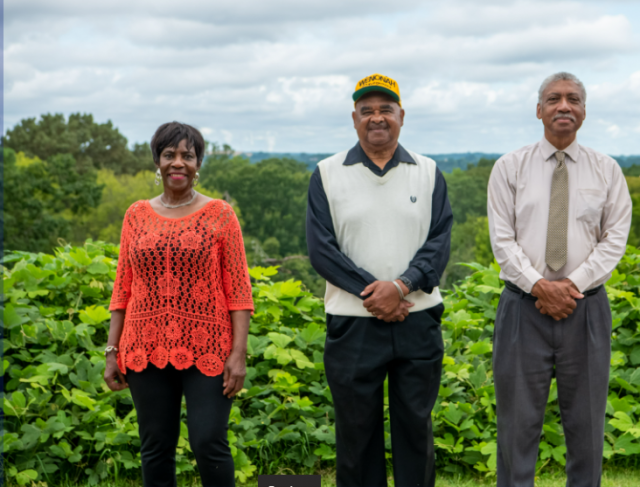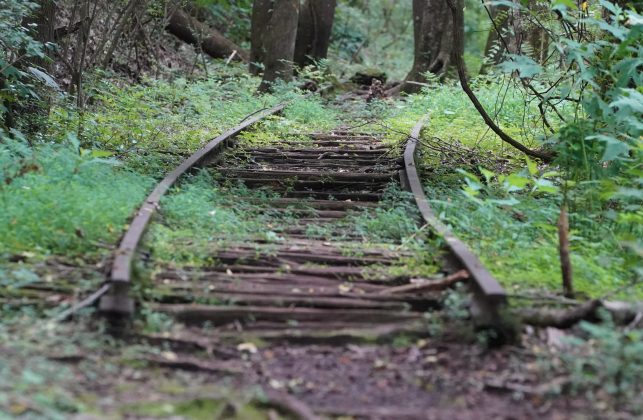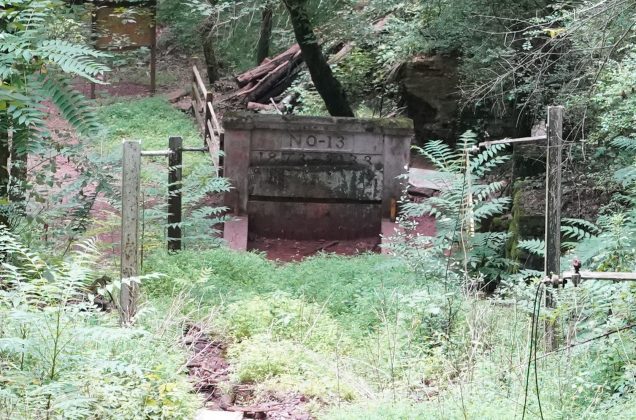
By Ryan Michaels
The Birmingham Times
Evanne Gibson, president of Birmingham’s West End Community, remembers when her brother, Ervin Batain, carved out the path behind his house in the Ishkooda community. Batain, who had kidney problems, had just gotten off dialysis after receiving a kidney transplant from an 11-year-old girl.
“After the dialysis he kind of changed a little bit, so he used to go outside to his backyard and just meditate,” Gibson said. “He started making his own path up there up on the mountain as a means of clearing his head and getting close to nature. … I think he might have been thinking about that little girl with asthma, [from whom he received the kidney].”
Batain’s safe space is now a park—Red Mountain Park (RMP), a 1,500-acre former mining complex completely within the city limits of Birmingham. It is mostly within the Oxmoor neighborhood but also spills into Tarpley City, West Goldwire, Garden Highlands, and Mason City.
As it stands today, RMP consists of 15 miles of trails, along which are picnic areas, overlooks, treehouses, zip lines, a six-acre dog park, and several old mines to observe.
Jefferson County Commissioner Sheila Tyson remembers Batain and Gibson taking her up the mountain in the 1990s.

“It was just beautiful. You could hear the birds and all of that out there,” Tyson remembered. “[Batain] had a dream of making a mountain trail that people could hike. I could see that because we had to actually hike and climb in order to see. His vision was amazing.”
Batain, who was born to the son of a miner in the Grasselli Heights neighborhood, became the first person to use the area now known as RMP. In 1999, he cleared a path from the backyard of his house into the abandoned Mine No. 11, one of the 15 mines that operated on the mountain.
During his trips to the mine, on which he would often take family, friends, and other locals, Batain collected numerous artifacts. He also started 3D at No. 11 Mining Camp and Nature Trail, an official nonprofit museum named for his three sons: Demetrius, Deon, and Devon.
Like her brother, Gibson, who is on the RMP board of commissioners, realizes the importance of the green space for people who live near Red Mountain, several of whom are dealing with health problems, such as diabetes and high blood pressure.
Batain died in 2014 from kidney failure. Up until that time, though, he “would go up on the trail and exercise,” Gibson said. “He started telling people about it … as a means of exercising your mind and your body.”
While RMP was officially established in 2012, Batain, known by some as the “The Prophet of Red Mountain,” was the first person to begin using the park as a tool for good in his community. Since then, numerous people have enjoyed benefits of the park, which commemorates its 10th anniversary next year.
Angela Grace, of the Lipscomb community, is one of those.
“First of all, I’m a nature lover—an avid nature lover,” she said recently at the park. “Number two: [My husband and I] are doing it for health purposes. It’s for our psyche.”
Latasha Holt, a resident of the Riley-Travellick community, said she and her husband got lost in the park but found the entire trek “relaxing.”
“We got lost for like two hours, but it was nice,” she said. “We found our way out, and it was a great workout that day. It’s something different. It gives you a nice place to relax, a place where you can feel safe to exercise or just walk and build relationships with your children, … a place where you can ride your bicycle and not worry about cars speeding past you. It gives you a sense of security and relaxation.”
The large natural space has allowed residents in West Birmingham, an area with little natural refuge, to become more accustomed to the beauty of nature, said Tyson, one of the park’s early and most ardent advocates.
“I think it’s a case of making our minds more healthy-thinking,” she said. “If you see green space, you think green space. If you see roads and factories and gas tanks, [on the other hand], it’s hard for you to have that type of vision … unless you specifically are interested in it.”
“The western side of Birmingham has such a negative image because the area has a lot of low-income housing . . ., and [some] roads that are not in good condition. Even though there are beautiful homes, there are abandoned homes, as well, so a lot of people don’t see the positive. [RMP], however, is our jewel,” Tyson said.
Its Many Facets
When Gibson first climbed the trail with Batain, she focused on the fresh air.
“I started going up there with him and noticed that the farther up you go, the fresher the air is,” Gibson recalled. “You can smell fresh air [on the mountain], so that was a means of wellness right there. … People in the community didn’t know the gold mine they had right in their backyard.”
Tyson remembers Batain and Gibson taking her up the mountain in the 1990s.
“It was just beautiful. You could hear the birds and all of that out there,” Tyson said. “[Batain] had a dream of making a mountain trail that people could hike. I could see that because we had to actually hike and climb in order to see. His vision was amazing.”
Beyond the natural health aspect, RMP the park is a tangible educational tool.
“There’s so much rich history there,” Tyson said. “When I say rich history, I mean it’s history that we can touch.”
The idea of using RMP the park as an immense educational tool is something that Lawson State Community College history instructor Gregory Wilson said he can visualize.
“I saw it as a multifaceted, multidisciplinary opportunity, not just in terms of my particular discipline but even with diversity as it relates to biology,” said Wilson, who has a master’s degree in education and is involved with various projects around Birmingham, including the Arlington Antebellum Home and Gardens, a former plantation house and six acres of landscaped gardens near downtown that features antebellum-era Greek revival-style architecture.
“[At RMP], I saw the geology, I saw the archaeology, I saw Native American history,” added Wilson, who has used the space to teach his own students by having them tour the space and ask questions of an archaeologist.
“Educators tend not to see [the potential] because it’s … a diamond in the rough,” he added. “They say, ‘If you bring us into a nice, air-conditioned building, that’s OK.’ But there’s a wealth of knowledge, history, and information outdoors.”
Beyond Its Luster
In the 1980s, historian Horace Huntley, a native of Birmingham’s Riley-Travellick neighborhood, was researching labor organization in the Magic City and developed some ideas about how to use the abandoned mines on the mountain as a public space.
“What I was imagining was having excursions into the mine, doing something similar to what had been done at Sloss, only these would be underground, rather than the above-ground [excursions] at Sloss,” said Huntley, referring to Birmingham’s Sloss Furnaces National Historic Landmark, which operated as an iron producing blast furnace from 1882 to 1971 and now serves as a museum and event venue.
While Huntley’s ideas were not used in the initial planning of RMP, the historian said he appreciates what has been done with the land in recent years.
“The present version of what Red Mountain is, that was not my idea. I just had an idea that preceded that,” said Huntley, who holds a Ph.D. in African American and labor history, has served as director of oral history work for the Birmingham Civil Rights Institute, and is a former University of Alabama at Birmingham professor that helped create the school’s African American studies curriculum.
“They’re doing a very good job in slowly developing that area [with] walking trails, parks, and different things across Red Mountain,” Huntley added.
RMP’s officials and board have attempted to include more of the surrounding communities. In 2019, a southern entrance was opened on Venice Road, giving more accessibility to residents of neighborhoods like Grasselli Heights, Tarpley City, and West Goldwire. Establishing that entrance made getting up to the park significantly easier for residents on that side of the mountain, Gibson said: “Whenever you have a place where you figure you can go without any resistance, you feel included.”
In addition to Gibson, RMP has 14 other board members, including Birmingham City Council District 6 City Councilor Crystal Smitherman and Tarpley City Neighborhood Association President Rosalind Young.
A Treasure for All
RMP Executive Director Thomas Carl “T.C.” McLemore said more people from Wenonah and surrounding communities have come to the park since the opening of the second entrance at Venice Road; the first entrance is at 2011 Frankfurt Drive, on the side of the park closer to Homewood.
“This has become an integrated part of everyday life for people in Wenonah,” he said. “The [Birmingham Police Department] officers that work here at the park, they have the regulars that they see every morning, people who walk up from the corner and into the park, go on their morning walk, walk back down, and go about their day.”
The southern entrance also opened only a few months before the onset of the COVID-19 pandemic, which led many more to visit the park using the new entrance.
“We’ve always walked at Red Mountain, but especially during [the pandemic],” said Lipscomb’s Grace. “It became one of our favorite places to walk, unwind, and relax. … This was one of the only places we could go during the height of the pandemic.”
McLemore said, “Though we didn’t realize it at the time, the timing of the opening of this entrance was great. This entrance in Wenonah opened in August 2019. When the pandemic hit at the beginning of 2020, we saw so many people from all over Birmingham, … really from all over the county and the state, coming [to RMP] in the earliest months of the pandemic.”
Beyond the new entrance, McLemore said he has made it a priority to keep in touch with the neighboring communities.
“[During my tenure as executive director], I’ve gone to a whole lot of community meetings, … just making sure we have clear lines of communication with community leaders. It has been really beneficial,” he said, adding that RMP really belongs to the people whose families lived in the area.
“It’s weird to think that I am even in a position to invite people from Wenonah here,” McLemore said. “This has been yours since before I was thought of.”
Before the western entrance was opened, Tarpley City Neighborhood Association President Young said, people “felt like [RMP] wasn’t part of the community,” but that area has always been important to those residents.
“It means a lot to Tarpley City and the surrounding areas because it goes back in our history,” Young said. “The mines have been part of our history for years.”






























